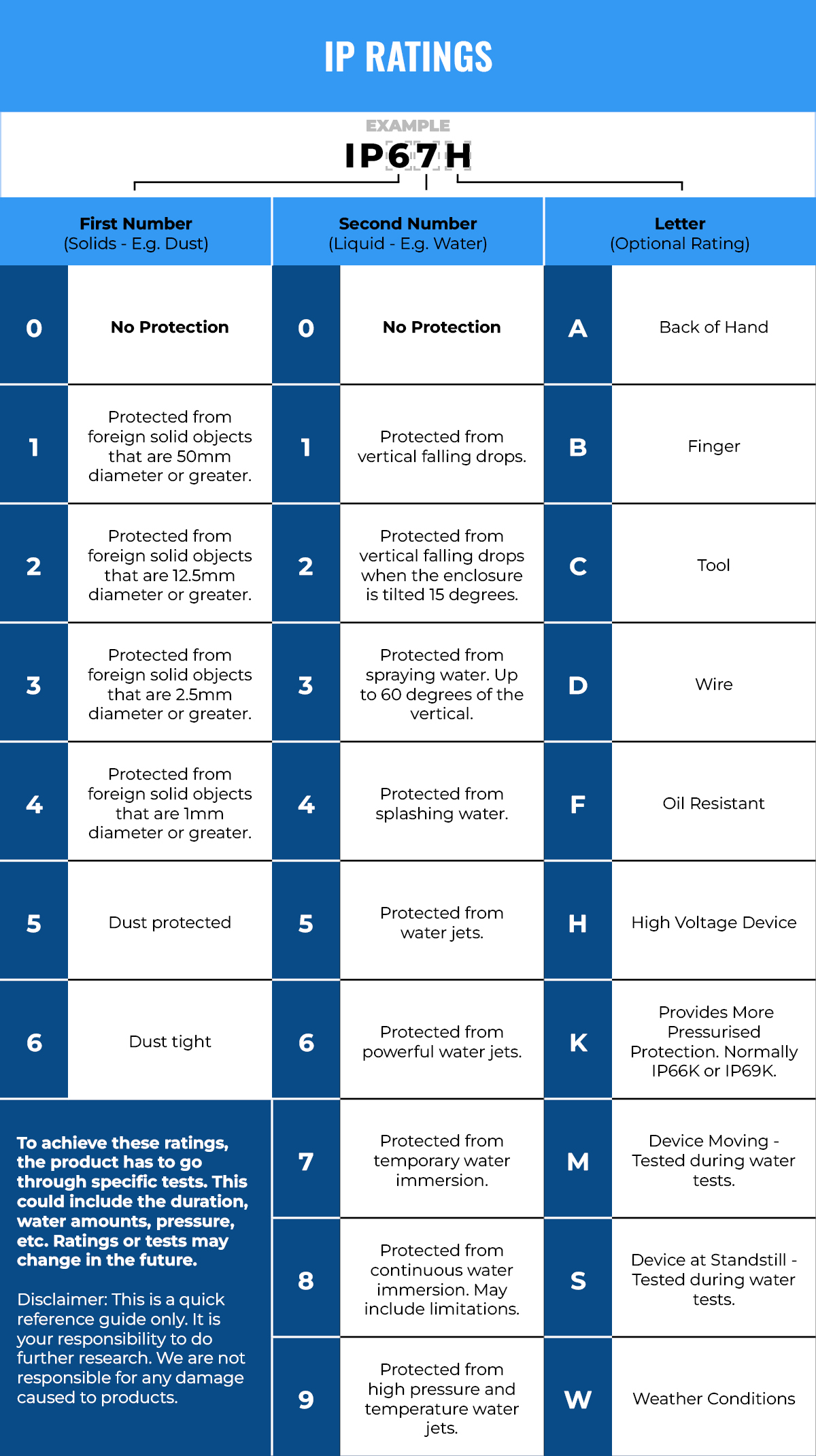We often see the term “IP rating” on packaging of products and you may often ask yourself “What is that?”, but most likely ignore it. However, in many situations, this rating should not be ignored.
In this article, you will learn what an IP rating is, and why it is so important to know what it is.
What is an IP rating?
An IP Rating (which stands for Ingress Protection Rating), is an international rating system which was developed by the IEC. It is used on products to indicate their level of protection against intrusion and damage from solids (e.g. dust), liquids (e.g. water) and optionally, pressure or other environmental effects that could damage a product.
You can generally find these numbers printed on packaging, product stickers or imprinted on the product or in product specification charts.
Each number means a different level or protection, while optionally, there will be a letter at the end to indicate the pressure it can withstand. Refer to our chart below for further detail on these numbers and our testing breakdown.
Products that may have IP Ratings
Various products can have an IP rating. Items you may come across with it include:
- All sorts of lighting products.
- Mobile phones – mostly water rated phones. E.g. when advertised as waterproof or water resistant.
- Marine equipment, including lighting.
- Other waterproof or water resistant rated devices, such as water resistance watches.
So Why is it important and what are the benefits?
1. You can select the right product for your circumstances
Imagine buying a fancy looking LED batten light for your garage. You may looked at the Lumens and Watts but most of the fancy batten lights either have an extremely low IP rating or no rating at all, and so you wouldn’t buy it for a garage where it’s prone to dust. Worst of all? Some of these lights don’t even open up for cleaning.
2. Know the limits of the product
Knowing the limits of your product allows you to provide greater care for that product and use it like it’s supposed to be used. For instance, phones that are advertised as water resistant have an IP rating, and while they are advertised as water resistant, the wording can be fairly vague without knowing their testing procedures.
3. You could extend the lifetime of the product and save!
You could save money in the long run by paying attention to the IP rating and save on further electrical call outs since certain products will last longer in different environments.
What do the numbers mean?
The higher the number, the more protection the product offers. The IP rating system is not a product certification and a product does not need to have an IP rating to be safe. However, it is a good indication of the level of protection a product is designed to provide in certain environmental conditions.
Take a look at our quick reference chart for more information.

Want to use this IP Rating Chart on your site? You must attribute to us with our business name “Ecotec Energy” and our website. This work is licensed under a Creative Commons Attribution 4.0 International License.
If you agree to the terms of the license, you may download the image here.
Testing
These are testing methods used upon posting of this article. While we give you part of the testing requirements, we may have missed some of the really technical specifications so it’s easier for you to understand and not overwhelm you with information, as it can get a little complex (such as involving units or pressure, etc.).
If you’re ever unsure, we recommend speaking to a professional for your personal circumstances.
First Number
1 – Protection against solid objects greater than 50 mm.
2 – Protection against solid objects greater than 12 mm.
3 – Protection against solid objects greater than 2.5 mm.
4 – Protection against solid objects greater than 1 mm.
5 – Protection against dust. Only a limited amount of ingress is allowed, no harmful amounts.
6 – Fully protected from dust. Tested for 8 hours duration based on airflow.
Second Number
1 – Protection against vertical falling droplets.
2 – Protection against vertical falling droplets when enclosure is tilted at 15 degrees.
3 – Protection against spraying water up to 60 degrees of the vertical.
4 – Protection against splashing water. Tested with an oscillating spray, for a total of 10minutes. A limited amount of ingress is permitted without harmful effects.
5 – Protection against water jets (low pressure). 6.3mm nozzle used to spray water from any angle. A limited amount of ingress is permitted without harmful effects.
6 – If there is a “K” rating letter at the end of this, it means it can withstand far more pressure. Protection against water jets (powerful). 12.5mm nozzle used to spray water from any angle.
7 – Protection against temporary, full immersion. Tested up to 30 minutes at depths between 15 cm and 1 metre. A limited amount of ingress is permitted without harmful effects.
8 – Protection against for a longer time and in deeper depths. The manufacturer sets out the test parameters for the duration, depths, etc. and depending on the product, they may also perform additional tests.
9K -Protection against high-pressure, high-temperature jet sprays, wash-downs or steam-cleaning procedures.
Conclusion
As you can see, an IP Rating is not just a number on a box that should just be ignored. However, seeking a higher number for protection with certain products may not be possible, so you may have a hard time finding a product that meets your personal standards.
We hope this was an informative article and we have provided you with enough knowledge for your next IP Rated product purchase.


